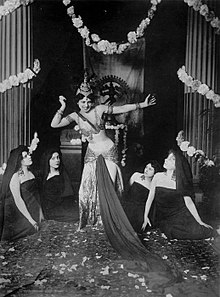Mata Hari
AKA
Margaretha Geertruida "Margreet" MacLeod

"So feline, extremely feminine, majestically tragic, the thousand curves and movements of her body trembling in a thousand rhythms."
-Uknown French Journalist
Later, the business went bankrupt due to bad investments and her parents divorced. Mata's mother fell ill and died when Mata was 15 years old. Her father remarried in Amsterdam on February 9th, 1893 to Susanna Catharina ten Hoove. Soon after, the family fell apart and Mata and her three brothers were split up and sent to live with various relatives.
Mata was living with her godfather, Mr. Visser, in Sneek, as she studied to be a kindergarten teacher in Leiden. The headmaster began to flirt with her and she was removed from the institution by Visser. A few months later, she fled to her uncle's home in The Hague.



They had two children, Norman-John and Louise " Nonnie" Jeanne. Norman died in 1899. Norman and Nonnie both either had syphilis or were poisoned for some known reason when they were in the Indies.
MacLeod openly kept a concubine and Mata temporarily moved in with Van Rheedes, another Dutch officer. She studied the Indonesian traditions intensely for several months and joined a local dance company during that time. In correspondence to her relatives in the Netherlands in 1897, she revealed her artistic name of Mata Hari, the word for "sun" in the local Malay language (literally, "eye of the day").
Mata did return to MacLeod, but after Norman died they moved back to the Netherlands and officially separated. The divorce became final in 1906. Mata was awarded custody of Nonnie and MacLeod was legally required to pay child support, which he never did. This made life difficult for Mata and Jeanne. During a visit of Jeanne with her father, MacLeod decided to keep her. Mata didn't have the resources to get her daughter back and tried to accept the loss of her Nonnie. Nonnie later died at the age of 21, possibly from complications relating to syphilis.
“I can get by well here in Paris,” Mata wrote, “but I am abstaining from everything for my child (so far). In the event that I am certain of never again being able to have her with me as her mother, then I shall care no longer and shall cast everything aside.”
Mata was lost without Nonnie and she moved to Paris where she performed as a circus horse rider using the name Lady MacLeod.
“I can get by well here in Paris,” Mata wrote, “but I am abstaining from everything for my child (so far). In the event that I am certain of never again being able to have her with me as her mother, then I shall care no longer and shall cast everything aside.”
She struggled to earn a living and tried every means to earn money respectably, giving piano lessons, teaching German, applying to work as a ladies’ companion and as a model a department store. But, eventually she posed as an artist's model for Montmartre painters such as Edouard Bisson, Octave Denis Victor Guillonnet and Fernand Cormon. This led her to important theatrical contacts.

The next year, Mata began to win fame as an exotic dancer by performing her "temple dance" she created by drawing on cultural and religious symbolism that she had picked up in the Indies. She billed herself as a Hindu artist. She would drape herself in veils and then drop them from her body until she wore just a jeweled breastplate and some ornaments upon her arms and head.
Mata had relationships with government and military men often for financial gain. Her liaisons with powerful men frequently took her across international borders. This was during World War I and she had some freedom of movement as a citizen of neutral Holland. Mata's travels attracted attention from British and French intelligence, who put her under surveillance.
The Deuxième Bureau believed Mata might be able to obtain information by seducing the Crown Prince Wilhelm for military secrets, who'd she had preform for before. He was the eldest son of Kaiser Wilhelm II and nominally a senior German general on the Western Front. In reality, the Crown Prince did not have much to do with the running of Army Group Crown Prince or the 5th Arm. He was practically a playboy and him being an highly involved great leader was propaganda. Mata's contact with the Deuxième Bureau was Captain Georges Ladoux, who was later to emerge as one of her principal accusers.
Mata's trial came when a time when France had been badly shaken by the Great Mutinies of the French Army. Real or imagined spies were convenient scapegoats for explaining military losses. Captain Georges Ladoux, made sure the evidence against her was constructed in the most damning way and even resorted to evidence tampering.
Clunet was denied permission either to cross-examine the prosecution's witnesses or to examine his own witnesses directly.
The military tribunal deliberated for less than 45 minutes before returning a guilty verdict.

Mata was 41-years-old when she was executed by firing squad of 12 French soldiers on October 15th, 1917. Dressed in a blue coat, a tri-corner hat and white gloves. She had arrived with a minister and two nuns and, after bidding them farewell, walked briskly to the designated spot. She was not bound and she had refused a blind fold. Mata turned to face the firing squad and blew the soldiers a kiss just before the shots rang out. A non-commissioned officer then walked up to her body, pulled out his revolver, and shot her in the head to make sure she was dead.
Mata's sealed trial and related other documents were scheduled to have been declassified by the French Army in 2017.

No comments:
Post a Comment